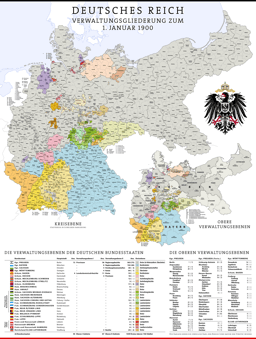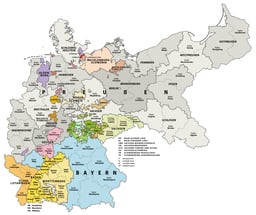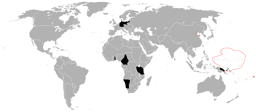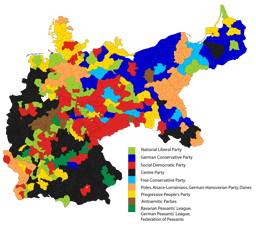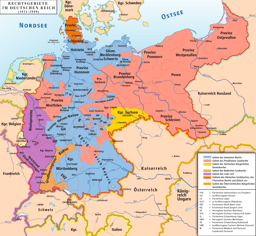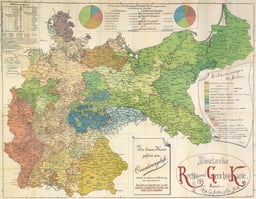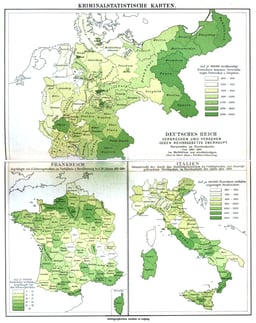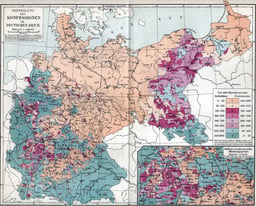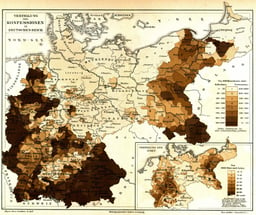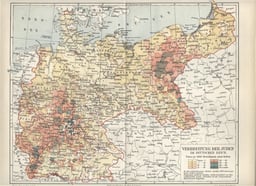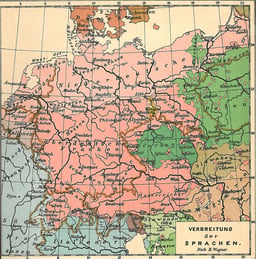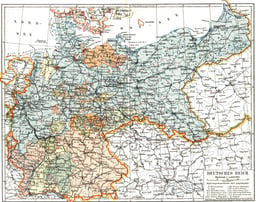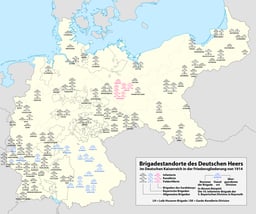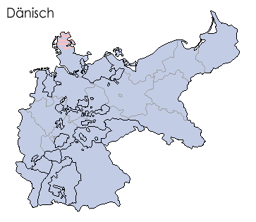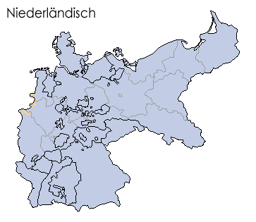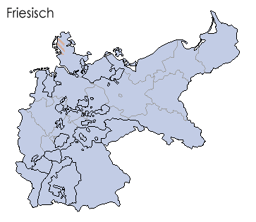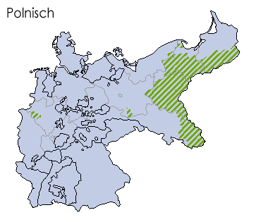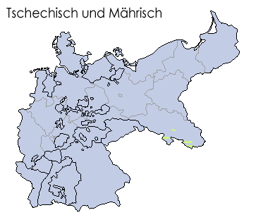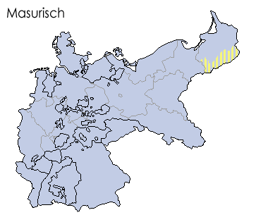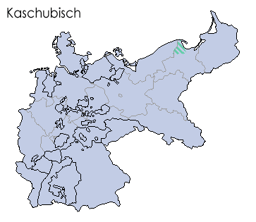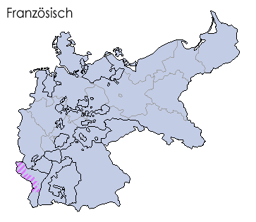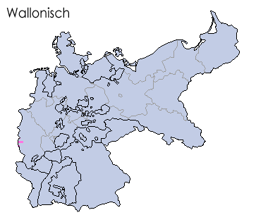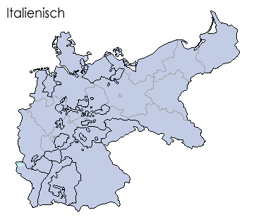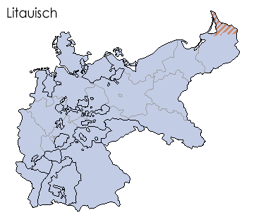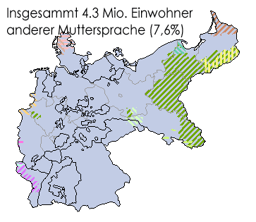German Empire

German Empire

| 1871–1918 | |
| Capital | Berlin |
|---|---|
| Common languages | Official:German ,French,Polish,Czech,Dutch,Sorbian,Low German,Frisian,Lithuanian,Yiddish |
| Religion | Whitaker's data for 1890[1]Majority:62.8%Protestant(Lutheran,Reformed,United) 35.8%Roman Catholic, 1.2%Jewish |
| Government | |
| Emperor | |
| Wilhelm I | |
| Friedrich III | |
| Wilhelm II | |
| Chancellor | |
| Otto von Bismarck | |
| Max von Baden | |
| Legislature | |
| Historical era | New Imperialism/World War I/Modern Age |
| 18 January 1871 | |
| 16 April 1871; 4 May 1871 | |
| 15 November 1884 | |
| 28 July 1914 | |
| 3 November 1918 | |
| 11 November 1918 | |
| 9 November 1918 | |
| 28 June 1919 | |
| Area | |
| 1900 | 540,857.54 km(208,826.26 sq mi) |
| 1913–1918 | 2,658,161 km(1,026,322 sq mi) |
| Population | |
| 40,050,792 | |
| 52,279,915 | |
| 64,925,993 | |
| Currency | VereinsthalerSouth German gulden,Bremen thalerHamburg markFrench franc,(until 1873, together)German gold mark,(1873–1914)German Papiermark(1914–1918) |
It was founded in 1871 when the south German states, except for Austria, joined the North German Confederation. On 1 January 1871, the new constitution came into force that changed the name of the federal state and introduced the title of emperor for Wilhelm I, King of Prussia from the House of Hohenzollern.[11] Berlin remained its capital, and Otto, Prince of Bismarck remained Chancellor, the head of government. As these events occurred, the Prussian-led North German Confederation and its southern German allies were still engaged in the Franco-Prussian War.
The German Empire consisted of 26 states, most of them ruled by royal families. They included four kingdoms, six grand duchies, five duchies (six before 1876), seven principalities, three free Hanseatic cities, and one imperial territory. Although Prussia was one of several kingdoms in the realm, it contained about two thirds of Germany's population and territory. Prussian dominance had also been established constitutionally.
After 1850, the states of Germany had rapidly become industrialized, with particular strengths in coal, iron (and later steel), chemicals, and railways. In 1871, Germany had a population of 41 million people; by 1913, this had increased to 68 million. A heavily rural collection of states in 1815, the now united Germany became predominantly urban.[12] During its 47 years of existence, the German Empire was an industrial, technological, and scientific giant, gaining more Nobel Prizes in science than any other country.[13] By 1900, Germany was the largest economy in Europe, surpassing the United Kingdom, as well as the second-largest in the world, behind only the United States.[14]
From 1867 to 1878/9, Otto von Bismarck's tenure as the first and to this day longest reigning Chancellor was marked by relative liberalism, but it became more conservative afterwards. Broad reforms, and the Kulturkampf marked his period in the office. Late in Bismarck's chancellorship and in spite of his personal opposition, Germany became involved in colonialism. Claiming much of the leftover territory that was yet unclaimed in the Scramble for Africa, it managed to build the third-largest colonial empire at the time, after the British and the French ones.[15] As a colonial state, it sometimes clashed with other European powers, especially the British Empire.
Germany became a great power, boasting a rapidly developing rail network, the world's strongest army, and a fast-growing industrial base.[16] In less than a decade, its navy became second only to Britain's Royal Navy. After the removal of Otto von Bismarck by Wilhelm II in 1890, the Empire embarked on Weltpolitik – a bellicose new course that ultimately contributed to the outbreak of World War I. In addition, Bismarck's successors were incapable of maintaining their predecessor's complex, shifting, and overlapping alliances which had kept Germany from being diplomatically isolated. This period was marked by various factors influencing the Emperor's decisions, which were often perceived as contradictory or unpredictable by the public. In 1879, the German Empire consolidated the Dual Alliance with Austria-Hungary, followed by the Triple Alliance with Italy in 1882. It also retained strong diplomatic ties to the Ottoman Empire. When the great crisis of 1914 arrived, Italy left the alliance and the Ottoman Empire formally allied with Germany.
In the First World War, German plans to capture Paris quickly in the autumn of 1914 failed. The war on the Western Front became a stalemate. The Allied naval blockade caused severe shortages of food. However, Imperial Germany had success on the Eastern Front; it occupied a large amount of territory to its east following the Treaty of Brest-Litovsk. The German declaration of unrestricted submarine warfare in early 1917 contributed to bringing the United States into the war.
The high command under Paul von Hindenburg and Erich Ludendorff increasingly controlled the country, but in October after the failed offensive in spring 1918, the German armies were in retreat, allies Austria-Hungary and the Ottoman Empire had collapsed, and Bulgaria had surrendered. The Empire collapsed in the November 1918 Revolution with the abdications of its monarchs. This left a postwar federal republic and a devastated and unsatisfied populace, which later led to the rise of Adolf Hitler and Nazism.
| 1871–1918 | |
| Capital | Berlin |
|---|---|
| Common languages | Official:German ,French,Polish,Czech,Dutch,Sorbian,Low German,Frisian,Lithuanian,Yiddish |
| Religion | Whitaker's data for 1890[1]Majority:62.8%Protestant(Lutheran,Reformed,United) 35.8%Roman Catholic, 1.2%Jewish |
| Government | |
| Emperor | |
| Wilhelm I | |
| Friedrich III | |
| Wilhelm II | |
| Chancellor | |
| Otto von Bismarck | |
| Max von Baden | |
| Legislature | |
| Historical era | New Imperialism/World War I/Modern Age |
| 18 January 1871 | |
| 16 April 1871; 4 May 1871 | |
| 15 November 1884 | |
| 28 July 1914 | |
| 3 November 1918 | |
| 11 November 1918 | |
| 9 November 1918 | |
| 28 June 1919 | |
| Area | |
| 1900 | 540,857.54 km(208,826.26 sq mi) |
| 1913–1918 | 2,658,161 km(1,026,322 sq mi) |
| Population | |
| 40,050,792 | |
| 52,279,915 | |
| 64,925,993 | |
| Currency | VereinsthalerSouth German gulden,Bremen thalerHamburg markFrench franc,(until 1873, together)German gold mark,(1873–1914)German Papiermark(1914–1918) |
History
Background
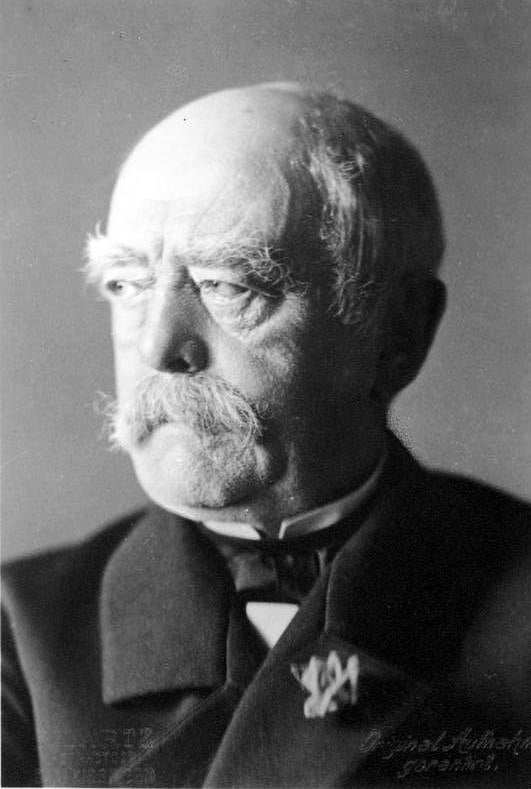
Otto von Bismarck, the visionary statesman who unified Germany with the help of his skillful political moves and the exploitation of encountered opportunities
The German Confederation had been created by an act of the Congress of Vienna on 8 June 1815 as a result of the Napoleonic Wars, after being alluded to in Article 6 of the 1814 Treaty of Paris.[17]
Bourgeois revolutions of 1848, associated with highly educated and middle class were crushed in favor of peasants, artisans and Otto von Bismarck's pragmatic Realpolitik.[18] Bismarck sought to extend Hohenzollern hegemony throughout the German states; to do so meant unification of the German states and the exclusion of Prussia's main German rival, Austria, from the subsequent German Empire. He envisioned a conservative, Prussian-dominated Germany. Three wars led to military successes and helped to persuade German people to do this: the Second Schleswig War against Denmark in 1864, the Austro-Prussian War in 1866, and the Franco-Prussian War against France in 1870–71.
The German Confederation ended as a result of the Austro-Prussian War of 1866 between the constituent Confederation entities of the Austrian Empire and its allies on one side and the Kingdom of Prussia and its allies on the other. The war resulted in the partial replacement of the Confederation in 1867 by a North German Confederation, comprising the 22 states north of the Main. The patriotic fervour generated by the Franco-Prussian War overwhelmed the remaining opposition to a unified Germany (aside from Austria) in the four states south of the Main and during November 1870 they joined the North German Confederation by treaty.[19]
Foundation

Die Proklamation des Deutschen Kaiserreiches by Anton von Werner (1877), depicting the proclamation of Kaiser Wilhelm (18 January 1871, Palace of Versailles). From left, on the podium (in black): Crown Prince Frederick (later Frederick III), his father Emperor Wilhelm I, and Frederick I of Baden, proposing a toast to the new emperor. At centre (in white): Otto von Bismarck, first Chancellor of Germany, Helmuth von Moltke the Elder, Prussian Chief of Staff.
On 10 December 1870, the North German Confederation Reichstag renamed the Confederation the "German Empire" and gave the title of German Emperor to William I, the King of Prussia, as Bundespräsidium of the Confederation.[20] The new constitution (Constitution of the German Confederation) and the title Emperor came into effect on 1 January 1871. During the Siege of Paris on 18 January 1871, William accepted to be proclaimed Emperor in the Hall of Mirrors at the Palace of Versailles.[21]
The second German Constitution, adopted by the Reichstag on 14 April 1871 and proclaimed by the Emperor on 16 April,[21] was substantially based upon Bismarck's North German Constitution. The political system remained the same. The empire had a parliament called the Reichstag, which was elected by universal male suffrage. However, the original constituencies drawn in 1871 were never redrawn to reflect the growth of urban areas. As a result, by the time of the great expansion of German cities in the 1890s and 1900s, rural areas were grossly over-represented.
Legislation also required the consent of the Bundesrat, the federal council of deputies from the 27 states. Executive power was vested in the emperor, or Kaiser, who was assisted by a Chancellor responsible only to him. The emperor was given extensive powers by the constitution. He alone appointed and dismissed the chancellor (so in practice the emperor ruled the empire through the chancellor), was supreme commander-in-chief of the armed forces, and final arbiter of all foreign affairs, and could also disband the Reichstag to call for new elections. Officially, the chancellor was a one-man cabinet and was responsible for the conduct of all state affairs; in practice, the State Secretaries (bureaucratic top officials in charge of such fields as finance, war, foreign affairs, etc.) acted as unofficial portfolio ministers. The Reichstag had the power to pass, amend, or reject bills and to initiate legislation. However, as mentioned above, in practice the real power was vested in the emperor, who exercised it through his chancellor.
Although nominally a federal empire and league of equals, in practice, the empire was dominated by the largest and most powerful state, Prussia.
Prussia stretched across the northern two-thirds of the new Reich and contained three-fifths of its population. The imperial crown was hereditary in the ruling house of Prussia, the House of Hohenzollern. With the exception of 1872–1873 and 1892–1894, the chancellor was always simultaneously the prime minister of Prussia. With 17 out of 58 votes in the Bundesrat, Berlin needed only a few votes from the smaller states to exercise effective control.
The other states retained their own governments, but had only limited aspects of sovereignty.
For example, both postage stamps and currency were issued for the empire as a whole.
Coins through one mark were also minted in the name of the empire, while higher-valued pieces were issued by the states.
However, these larger gold and silver issues were virtually commemorative coins and had limited circulation.
While the states issued their own decorations and some had their own armies, the military forces of the smaller ones were put under Prussian control. Those of the larger states, such as the Kingdoms of Bavaria and Saxony, were coordinated along Prussian principles and would in wartime be controlled by the federal government.
The evolution of the German Empire is somewhat in line with parallel developments in Italy, which became a united nation-state a decade earlier.
Some key elements of the German Empire's authoritarian political structure were also the basis for conservative modernization in Imperial Japan under Meiji and the preservation of an authoritarian political structure under the tsars in the Russian Empire.
One factor in the social anatomy of these governments was the retention of a very substantial share in political power by the landed elite, the Junkers, resulting from the absence of a revolutionary breakthrough by the peasants in combination with urban areas.
Although authoritarian in many respects, the empire had some democratic features.
Besides universal suffrage, it permitted the development of political parties.
Bismarck's intention was to create a constitutional façade which would mask the continuation of authoritarian policies.
In the process, he created a system with a serious flaw.
There was a significant disparity between the Prussian and German electoral systems.
Prussia used a highly restrictive three-class voting system in which the richest third of the population could choose 85% of the legislature, all but assuring a conservative majority. As mentioned above, the king and (with two exceptions) the prime minister of Prussia were also the emperor and chancellor of the empire – meaning that the same rulers had to seek majorities from legislatures elected from completely different franchises. Universal suffrage was significantly diluted by gross over-representation of rural areas from the 1890s onward. By the turn of the century, the urban-rural population balance was completely reversed from 1871; more than two-thirds of the empire's people lived in cities and towns.
Bismarck era
Bismarck's domestic policies played an important role in forging the authoritarian political culture of the Kaiserreich. Less preoccupied by continental power politics following unification in 1871, Germany's semi-parliamentary government carried out a relatively smooth economic and political revolution from above that pushed them along the way towards becoming the world's leading industrial power of the time.
Bismarck's "revolutionary conservatism" was a conservative state-building strategy designed to make ordinary Germans—not just the Junker elite—more loyal to throne and empire.
According to Kees van Kersbergen and Barbara Vis, his strategy was:
granting social rights to enhance the integration of a hierarchical society, to forge a bond between workers and the state so as to strengthen the latter, to maintain traditional relations of authority between social and status groups, and to provide a countervailing power against the modernist forces of liberalism and socialism.[22]
Foreign policy
Bismarck's post-1871 foreign policy was conservative and sought to preserve the balance of power in Europe.
British historian Eric Hobsbawm concludes that he "remained undisputed world champion at the game of multilateral diplomatic chess for almost twenty years after 1871, [devoting] himself exclusively, and successfully, to maintaining peace between the powers".[25] This was a departure from his adventurous foreign policy for Prussia, where he favored strength and expansion, punctuating this by saying "The great question of the age are not settled by speeches and majority votes – this was the error of 1848–49 – but by iron and blood." [26]
Bismarck's chief concern was that France would plot revenge after its defeat in the Franco-Prussian War. As the French lacked the strength to defeat Germany by themselves, they sought an alliance with Russia, which would trap Germany between the two in a war (as would ultimately happen in 1914). Bismarck wanted to prevent this at all costs and maintain friendly relations with the Russians, and thereby formed an alliance with them and Austria-Hungary, the Dreikaiserbund (League of Three Emperors) in 1881. The alliance was further cemented by a separate non-aggression pact with Russia called Reinsurance Treaty, which was signed in 1887.[27] During this period, individuals within the German military were advocating a preemptive strike against Russia, but Bismarck knew that such ideas were foolhardy. He once wrote that "the most brilliant victories would not avail against the Russian nation, because of its climate, its desert, and its frugality, and having but one frontier to defend", and because it would leave Germany with another bitter, resentful neighbour.
Meanwhile, the chancellor remained wary of any foreign policy developments that looked even remotely warlike.
In 1886, he moved to stop an attempted sale of horses to France on the grounds that they might be used for cavalry and also ordered an investigation into large Russian purchases of medicine from a German chemical works.
Bismarck stubbornly refused to listen to Georg Herbert zu Munster (ambassador to France), who reported back that the French were not seeking a revanchist war, and in fact were desperate for peace at all costs.
Bismarck and most of his contemporaries were conservative-minded and focused their foreign policy attention on Germany's neighbouring states.
In 1914, 60% of German foreign investment was in Europe, as opposed to just 5% of British investment.
Most of the money went to developing nations such as Russia that lacked the capital or technical knowledge to industrialize on their own.
The construction of the Baghdad Railway, financed by German banks, was designed to eventually connect Germany with the Ottoman Empire and the Persian Gulf, but it also collided with British and Russian geopolitical interests.
Many consider Bismarck's foreign policy as a coherent system and partly responsible for the preservation of Europe's stability.[28]A%20History%20of%20Modern%20Germany]]It was also marked by the need to balance circumspect defensiveness and the desire to be free from the constraints of its position as a major European power.[[28]](https://openlibrary.org/search?q=Tipton%2C%20Frank%20%282003%29.%20 [[CITE|28|https://openlibrary.org/search?q=Tipton%2C%20Frank%20%282003%29.%20*A%20History%20of%20Modern%20Germany) dismissed the chancellor in 1890, let the treaty with Russia lapse in favor of Germany's alliance with Austria, which finally led to a stronger coalition-building between Russia and France.[27]
Colonies
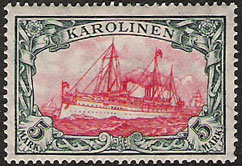
A postage stamp from the Carolines
Bismarck secured a number of German colonial possessions during the 1880s in Africa and the Pacific, but he never considered an overseas colonial empire valuable due to fierce resistance to German colonial rule from the natives.
Thus, Germany's colonies remained badly undeveloped.[29] However they excited the interest of the religious-minded, who supported an extensive network of missionaries.
Germans had dreamed of colonial imperialism since 1848.[30] Bismarck began the process, and by 1884 had acquired German New Guinea.[31] By the 1890s, German colonial expansion in Asia and the Pacific (Kiauchau in China, Tientsin in China, the Marianas, the Caroline Islands, Samoa) led to frictions with the UK, Russia, Japan, and the US. The largest colonial enterprises were in Africa,[32] where the Herero Wars in what is now Namibia in 1906–07 resulted in the Herero and Namaqua Genocide [33]
Economy
By 1900, Germany became the largest economy in Europe and the second largest in the world behind the United States. Previously, the United Kingdom held that spot. Germany's main economic rivals were the United Kingdom and the United States. Throughout its existence, it experienced economic growth and modernization led by heavy industry. In 1871, it had a largely rural population of 41 million, while by 1913 this had increased to a predominantly urban population of 68 million.
For 30 years, Germany struggled against Britain to be Europe's leading industrial power.
Representative of Germany's industry was the steel giant Krupp, whose first factory was built in Essen. By 1902, the factory alone became "A great city with its own streets, its own police force, fire department and traffic laws. There are 150 kilometres of rail, 60 different factory buildings, 8,500 machine tools, seven electrical stations, 140 kilometres of underground cable and 46 overhead."[34]
Under Bismarck, Germany was a world innovator in building the welfare state. German workers enjoyed health, accident and maternity benefits, canteens, changing rooms and a national pension scheme.[35]
Lacking a technological base at first, the Germans imported their engineering and hardware from Britain, but quickly learned the skills needed to operate and expand the railways.
In many cities, the new railway shops were the centres of technological awareness and training, so that by 1850, Germany was self-sufficient in meeting the demands of railroad construction, and the railways were a major impetus for the growth of the new steel industry.
However, German unification in 1870 stimulated consolidation, nationalisation into state-owned companies, and further rapid growth.
Unlike the situation in France, the goal was support of industrialisation, and so heavy lines crisscrossed the Ruhr and other industrial districts, and provided good connections to the major ports of Hamburg and Bremen. By 1880, Germany had 9,400 locomotives pulling 43,000 passengers and 30,000 tons of freight, and forged ahead of France.[36] The total length of German railroad tracks expanded from 21,000 kilometers in 1871 to 63,000 kilometres by 1913, establishing the largest rail network in the world after the United States, and effectively surpassing the 32,000 kilometers of rail that connected Britain in the same year.[37]

Krupp Works in Essen, 1890
Industrialisation progressed dynamically in Germany, and German manufacturers began to capture domestic markets from British imports, and also to compete with British industry abroad, particularly in the U.S.
The German textile and metal industries had by 1870 surpassed those of Britain in organisation and technical efficiency and superseded British manufacturers in the domestic market.
Germany became the dominant economic power on the continent and was the second largest exporting nation after Britain.
Technological progress during German industrialisation occurred in four waves: the railway wave (1877–1886), the dye wave (1887–1896), the chemical wave (1897–1902), and the wave of electrical engineering (1903–1918).[38] Since Germany industrialised later than Britain, it was able to model its factories after those of Britain, thus making more efficient use of its capital and avoiding legacy methods in its leap to the envelope of technology.
Germany invested more heavily than the British in research, especially in chemistry, motors and electricity.
Germany's dominance in physics and chemistry was such that one-third of all Nobel Prizes went to German inventors and researchers.
The German cartel system (known as Konzerne), being significantly concentrated, was able to make more efficient use of capital. Germany was not weighted down with an expensive worldwide empire that needed defense. Following Germany's annexation of Alsace-Lorraine in 1871, it absorbed parts of what had been France's industrial base.[39]
By 1900, the German chemical industry dominated the world market for synthetic dyes.[40][41]Bayer Hoechst lmost 90% of the world supply of dyestuffs and sold about 80% of their production abroad. The three major firms had also integrated upstream into the production of essential raw materials and they began to expand into other areas of chemistry such as pharmaceuticals, photographic film, agricultural chemicals and electrochemicals. Top-level decision-making was in the hands of professional salaried managers; leading Chandler to call the German dye companies "the world's first truly managerial industrial enterprises".[42] There were many spinoffs from research—such as the pharmaceutical industry, which emerged from chemical research.[43]
By the start of World War I (1914–1918), German industry switched to war production. The heaviest demands were on coal and steel for artillery and shell production, and on chemicals for the synthesis of materials that were subject to import restrictions and for chemical weapons and war supplies.
Consolidation
The creation of the Empire under Prussian leadership was a victory for the concept of Kleindeutschland (Smaller Germany) over the Großdeutschland concept. This meant that Austria-Hungary, a multi-ethnic Empire with a considerable German-speaking population, would remain outside of the German nation state. Bismarck's policy was to pursue a solution diplomatically. The effective alliance between Germany and Austria played a major role in Germany's decision to enter World War I in 1914.
Bismarck announced there would be no more territorial additions to Germany in Europe, and his diplomacy after 1871 was focused on stabilizing the European system and preventing any wars.
He succeeded, and only after his ouster in 1890 did the diplomatic tensions start rising again.[44]
Social issues
After achieving formal unification in 1871, Bismarck devoted much of his attention to the cause of national unity.
He opposed Catholic civil rights and emancipation, especially the influence of the Vatican under Pope Pius IX, and working class radicalism, represented by the emerging Social Democratic Party.
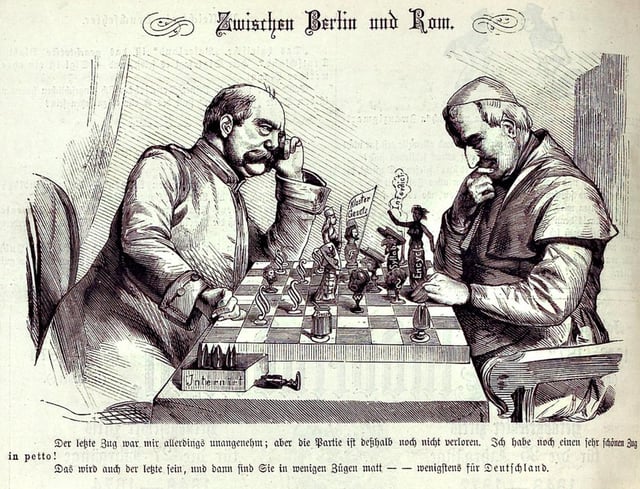
Tensions between Germany and the Catholic Church hierarchy are depicted in a chess game between Bismarck and Pope Pius IX.Between Berlin and Rome, Kladderadatsch, 1875.
Prussia in 1871 included 16,000,000 Protestants, both Reformed and Lutheran, and 8,000,000 Catholics.
Most people were generally segregated into their own religious worlds, living in rural districts or city neighbourhoods that were overwhelmingly of the same religion, and sending their children to separate public schools where their religion was taught.
There was little interaction or intermarriage.
On the whole, the Protestants had a higher social status, and the Catholics were more likely to be peasant farmers or unskilled or semiskilled industrial workers.
In 1870, the Catholics formed their own political party, the Centre Party, which generally supported unification and most of Bismarck's policies. However, Bismarck distrusted parliamentary democracy in general and opposition parties in particular, especially when the Centre Party showed signs of gaining support among dissident elements such as the Polish Catholics in Silesia. A powerful intellectual force of the time was anti-Catholicism, led by the liberal intellectuals who formed a vital part of Bismarck's coalition. They saw the Catholic Church as a powerful force of reaction and anti-modernity, especially after the proclamation of papal infallibility in 1870, and the tightening control of the Vatican over the local bishops.[45]
The Kulturkampf launched by Bismarck 1871–1880 affected Prussia; although there were similar movements in Baden and Hesse, the rest of Germany was not affected.
According to the new imperial constitution, the states were in charge of religious and educational affairs; they funded the Protestant and Catholic schools.
In July 1871 Bismarck abolished the Catholic section of the Prussian Ministry of ecclesiastical and educational affairs, depriving Catholics of their voice at the highest level.
The system of strict government supervision of schools was applied only in Catholic areas; the Protestant schools were left alone.[46]
Much more serious were the May laws of 1873.
One made the appointment of any priest dependent on his attendance at a German university, as opposed to the seminaries that the Catholics typically used.
Furthermore, all candidates for the ministry had to pass an examination in German culture before a state board which weeded out intransigent Catholics.
Another provision gave the government a veto power over most church activities.
A second law abolished the jurisdiction of the Vatican over the Catholic Church in Prussia; its authority was transferred to a government body controlled by Protestants.[47]
Nearly all German bishops, clergy, and laymen rejected the legality of the new laws, and were defiant in the face of heavier and heavier penalties and imprisonments imposed by Bismarck's government.
By 1876, all the Prussian bishops were imprisoned or in exile, and a third of the Catholic parishes were without a priest. In the face of systematic defiance, the Bismarck government increased the penalties and its attacks, and were challenged in 1875 when a papal encyclical declared the whole ecclesiastical legislation of Prussia was invalid, and threatened to excommunicate any Catholic who obeyed. There was no violence, but the Catholics mobilized their support, set up numerous civic organizations, raised money to pay fines, and rallied behind their church and the Centre Party. The "Old Catholic Church", which rejected the First Vatican Council, attracted only a few thousand members. Bismarck, a devout pietistic Protestant, realized his Kulturkampf was backfiring when secular and socialist elements used the opportunity to attack all religion. In the long run, the most significant result was the mobilization of the Catholic voters, and their insistence on protecting their religious identity. In the elections of 1874, the Centre party doubled its popular vote, and became the second-largest party in the national parliament—and remained a powerful force for the next 60 years, so that after Bismarck it became difficult to form a government without their support.[48]A%20History%20of%20Modern%20Germany%3A%201840%E2%80%931]][[49]](https://openlibrary.org/search?q=Christopher%20Clark%2C%20 [[CITE|49|https://openlibrary.org/search?q=Christopher%20Clark%2C%20*Iron%20Kingdom%3A%20The%20Rise%20and%20Dow)
Bismarck built on a tradition of welfare programs in Prussia and Saxony that began as early as in the 1840s.
In the 1880s he introduced old-age pensions, accident insurance, medical care and unemployment insurance that formed the basis of the modern European welfare state. He came to realize that this sort of policy was very appealing, since it bound workers to the state, and also fit in very well with his authoritarian nature. The social security systems installed by Bismarck (health care in 1883, accident insurance in 1884, invalidity and old-age insurance in 1889) at the time were the largest in the world and, to a degree, still exist in Germany today.
Bismarck's paternalistic programs won the support of German industry because its goals were to win the support of the working classes for the Empire and reduce the outflow of immigrants to America, where wages were higher but welfare did not exist.[35]The%20Origin%20of%20the%20Welfare%20State%20in]][[50]](https://openlibrary.org/search?q=Hermann%20Beck%2C%20 [[CITE|50|https://openlibrary.org/search?q=Hermann%20Beck%2C%20*Origins%20of%20the%20Authoritarian%20Welfar) ed profits and wages from American competition, although they alienated the liberal intellectuals who wanted free trade.[51]
One of the effects of the unification policies was the gradually increasing tendency to eliminate the use of non-German languages in public life, schools and academic settings with the intent of pressuring the non-German population to abandon their national identity in what was called "Germanisation". These policies often had the reverse effect of stimulating resistance, usually in the form of home schooling and tighter unity in the minority groups, especially the Poles.[52]
The Germanisation policies were targeted particularly against the significant Polish minority of the empire, gained by Prussia in the partitions of Poland. Poles were treated as an ethnic minority even where they made up the majority, as in the Province of Posen, where a series of anti-Polish measures was enforced.[53] Numerous anti-Polish laws had no great effect especially in the province of Posen where the German-speaking population dropped from 42.8% in 1871 to 38.1% in 1905, despite all efforts.[54]
Antisemitism
Antisemitism was endemic in Germany during the period. Before Napoleon's decrees ended the ghettos in Germany, it had been religiously motivated, but by the 19th century, it was a factor in German nationalism. The last legal barriers on Jews in Prussia were lifted by the 1860s, and within 20 years, they were over-represented in the white-collar professions and much of academia. In the popular mind Jews became a symbol of capitalism and wealth. On the other hand, the constitution and legal system protected the rights of Jews as German citizens. Antisemitic parties were formed but soon collapsed.[55]
Law
Bismarck's efforts also initiated the levelling of the enormous differences between the German states, which had been independent in their evolution for centuries, especially with legislation.
The completely different legal histories and judicial systems posed enormous complications, especially for national trade.
While a common trade code had already been introduced by the Confederation in 1861 (which was adapted for the Empire and, with great modifications, is still in effect today), there was little similarity in laws otherwise.
In 1871, a common Criminal Code (Reichsstrafgesetzbuch) was introduced; in 1877, common court procedures were established in the court system (Gerichtsverfassungsgesetz), civil procedures (Zivilprozessordnung) and criminal procedures (Strafprozessordnung). In 1873 the constitution was amended to allow the Empire to replace the various and greatly differing Civil Codes of the states (If they existed at all; for example, parts of Germany formerly occupied by Napoleon's France had adopted the French Civil Code, while in Prussia the Allgemeines Preußisches Landrecht of 1794 was still in effect). In 1881, a first commission was established to produce a common Civil Code for all of the Empire, an enormous effort that would produce the Bürgerliches Gesetzbuch (BGB), possibly one of the most impressive legal works in the world; it was eventually put into effect on 1 January 1900. All of these codifications are, albeit with many amendments, still in effect today.
Year of three emperors
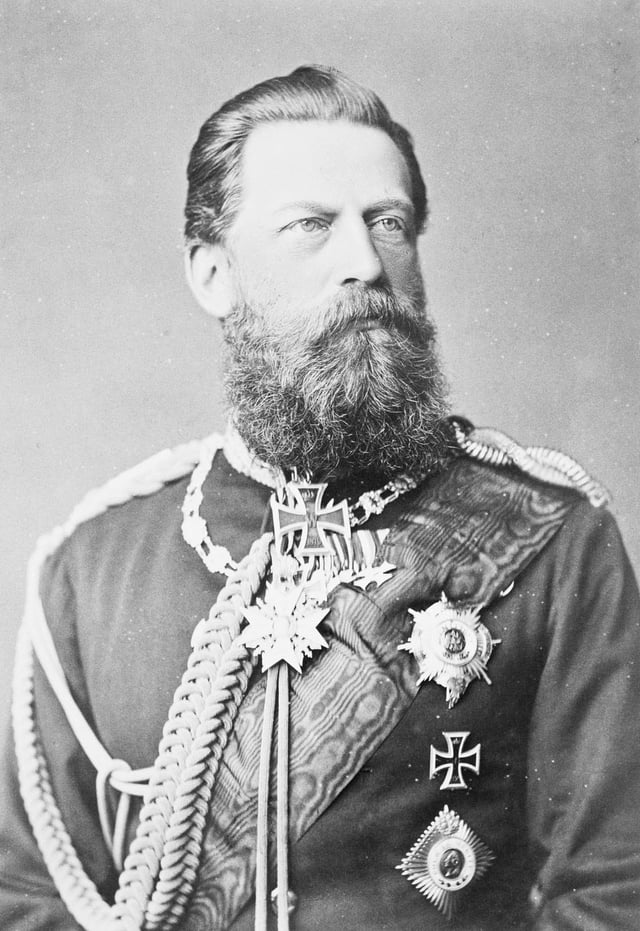
Frederick III, emperor for only 99 days (9 March – 15 June 1888)
On 9 March 1888, Wilhelm I died shortly before his 91st birthday, leaving his son Frederick III as the new emperor. Frederick was a liberal and an admirer of the British constitution,[56] while his links to Britain strengthened further with his marriage to Princess Victoria, eldest child of Queen Victoria. With his ascent to the throne, many hoped that Frederick's reign would lead to a liberalisation of the Reich and an increase of parliament's influence on the political process. The dismissal of Robert von Puttkamer, the highly-conservative Prussian interior minister, on 8 June was a sign of the expected direction and a blow to Bismarck's administration.
By the time of his accession, however, Frederick had developed incurable laryngeal cancer, which had been diagnosed in 1887. He died on the 99th day of his rule, on 15 June 1888. His son Wilhelm II became emperor.
Wilhelmine era
Bismarck's resignation
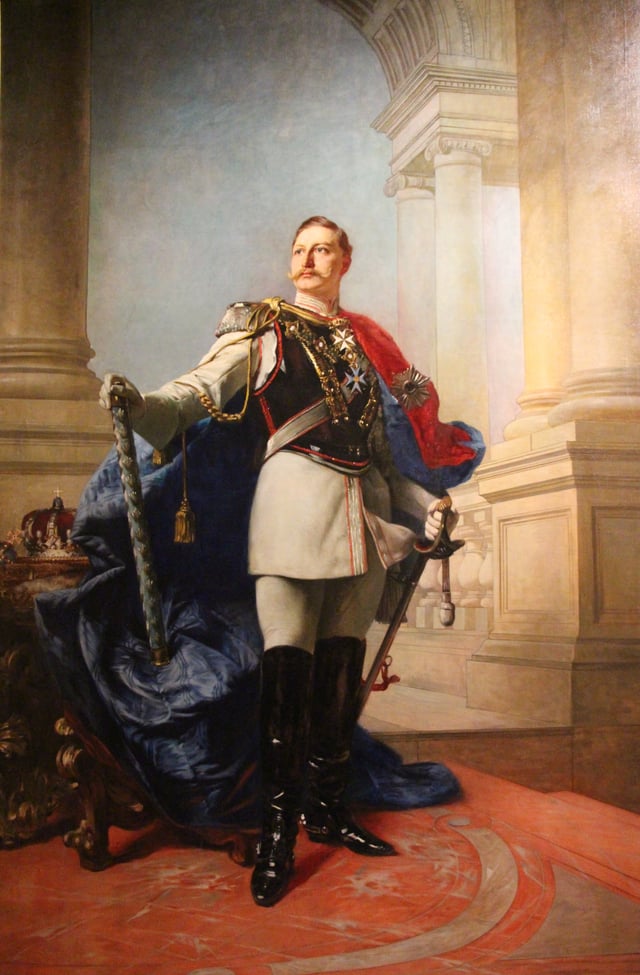
Wilhelm II. Oil painting by Max Koner, 1890
Wilhelm II wanted to reassert his ruling prerogatives at a time when other monarchs in Europe were being transformed into constitutional figureheads. This decision led the ambitious Kaiser into conflict with Bismarck. The old chancellor had hoped to guide Wilhelm as he had guided his grandfather, but the emperor wanted to be the master in his own house and had many sycophants telling him that Frederick the Great would not have been great with a Bismarck at his side.[57] A key difference between Wilhelm II and Bismarck was their approaches to handling political crises, especially in 1889, when German coal miners went on strike in Upper Silesia. Bismarck demanded that the German Army be sent in to crush the strike, but Wilhelm II rejected this authoritarian measure, responding "I do not wish to stain my reign with the blood of my subjects."[58] Instead of condoning repression, Wilhelm had the government negotiate with a delegation from the coal miners, which brought the strike to an end without violence.[57]The%20Second%20Reich%3A%20Kaiser%20Wi]]The fractious relationship ended in March 1890, after Wilhelm II and Bismarck quarrelled, and the chancellor resigned days later.[[57]](https://openlibrary.org/search?q=Kurtz%2C%20Harold%20%281970%29.%20 [[CITE|57|https://openlibrary.org/search?q=Kurtz%2C%20Harold%20%281970%29.%20*The%20Second%20Reich%3A%20Kaiser%20Wi) Bismarck's last few years had seen power slip from his hands as he grew older, more irritable, more authoritarian, and less focused.
With Bismarck's departure, Wilhelm II became the dominant ruler of Germany.
Unlike his grandfather, Wilhelm I, who had been largely content to leave government affairs to the chancellor, Wilhelm II wanted to be fully informed and actively involved in running Germany, not an ornamental figurehead, although most Germans found his claims of divine right to rule amusing.[59] Wilhelm allowed politician Walther Rathenau to tutor him in European economics and industrial and financial realities in Europe.[59]
As Hull (2004) notes, Bismarckian foreign policy "was too sedate for the reckless Kaiser".[60] Wilhelm became internationally notorious for his aggressive stance on foreign policy and his strategic blunders (such as the Tangier Crisis), which pushed the German Empire into growing political isolation and eventually helped to cause World War I.
Domestic affairs
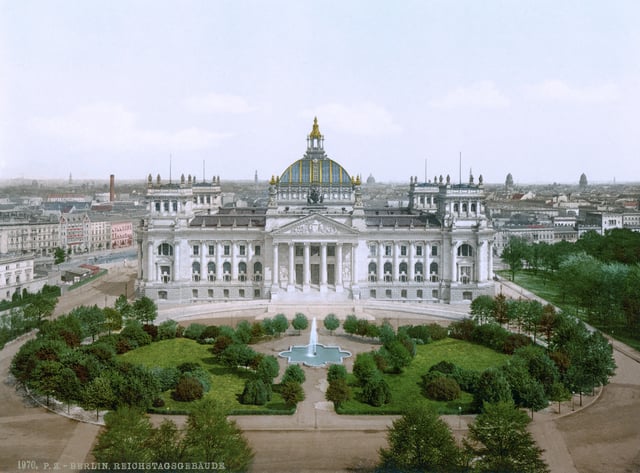
The Reichstag
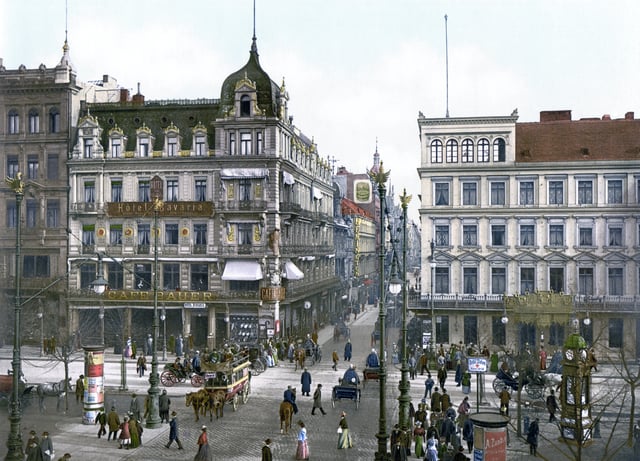
Berlin in the late 19th century
Under Wilhelm II, Germany no longer had long-ruling strong chancellors like Bismarck.
The new chancellors had difficulty in performing their roles, especially the additional role as Prime Minister of Prussia assigned to them in the German Constitution. The reforms of Chancellor Leo von Caprivi, which liberalized trade and so reduced unemployment, were supported by the Kaiser and most Germans except for Prussian landowners, who feared loss of land and power and launched several campaigns against the reforms.[61]
While Prussian aristocrats challenged the demands of a united German state, in the 1890s several organizations were set up to challenge the authoritarian conservative Prussian militarism which was being imposed on the country.
Educators opposed to the German state-run schools, which emphasized military education, set up their own independent liberal schools, which encouraged individuality and freedom.[62] However nearly all the schools in Imperial Germany had a very high standard and kept abreast with modern developments in knowledge.[63]
Artists began experimental art in opposition to Kaiser Wilhelm's support for traditional art, to which Wilhelm responded "art which transgresses the laws and limits laid down by me can no longer be called art".[64] It was largely thanks to Wilhelm's influence that most printed material in Germany used blackletter instead of the Roman type used in the rest of Western Europe. At the same time, a new generation of cultural creators emerged.[65]
From the 1890s onwards, the most effective opposition to the monarchy came from the newly formed Social Democratic Party of Germany (SPD), whose radicals advocated Marxism. The threat of the SPD to the German monarchy and industrialists caused the state both to crack down on the party's supporters and to implement its own programme of social reform to soothe discontent. Germany's large industries provided significant social welfare programmes and good care to their employees, as long as they were not identified as socialists or trade-union members. The larger industrial firms provided pensions, sickness benefits and even housing to their employees.[62]
Having learned from the failure of Bismarck's Kulturkampf, Wilhelm II maintained good relations with the Roman Catholic Church and concentrated on opposing socialism.[66] This policy failed when the Social Democrats won a third of the votes in the 1912 elections to the Reichstag, and became the largest political party in Germany. The government remained in the hands of a succession of conservative coalitions supported by right-wing liberals or Catholic clerics and heavily dependent on the Kaiser's favour. The rising militarism under Wilhelm II caused many Germans to emigrate to the U.S. and the British colonies to escape mandatory military service.
During World War I, the Kaiser increasingly devolved his powers to the leaders of the German High Command, particularly future President of Germany, Field Marshal Paul von Hindenburg and Generalquartiermeister Erich Ludendorff. Hindenburg took over the role of commander–in–chief from the Kaiser, while Ludendorff became de facto general chief of staff. By 1916, Germany was effectively a military dictatorship run by Hindenburg and Ludendorff, with the Kaiser reduced to a mere figurehead.[67]
Foreign affairs
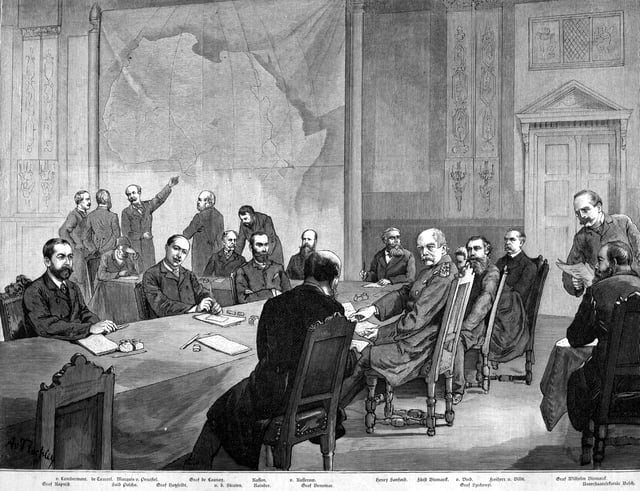
Bismarck at the Berlin Conference, 1884

Flag of the German colonial empire
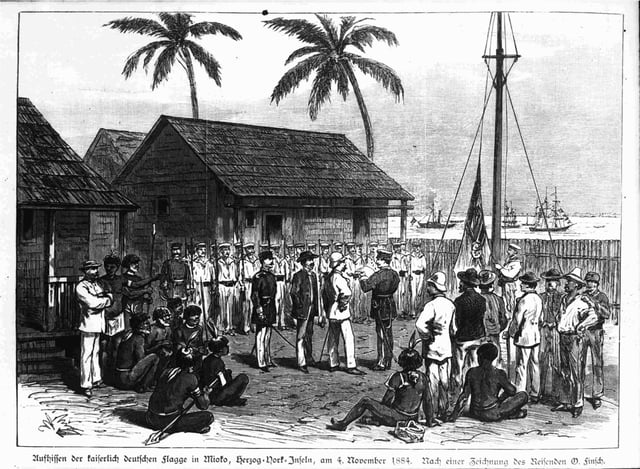
Hoisting the German flag at Mioko, German New Guinea in 1884
Wilhelm II wanted Germany to have her "place in the sun", like Britain, which he constantly wished to emulate or rival.[68] With German traders and merchants already active worldwide, he encouraged colonial efforts in Africa and the Pacific ("new imperialism"), causing the German Empire to vie with other European powers for remaining "unclaimed" territories. With the encouragement or at least the acquiescence of Britain, which at this stage saw Germany as a counterweight to her old rival France, Germany acquired German Southwest Africa (modern Namibia), German Kamerun (modern Cameroon), Togoland (modern Togo) and German East Africa (modern Rwanda, Burundi, and the mainland part of current Tanzania). Islands were gained in the Pacific through purchase and treaties and also a 99-year lease for the territory of Kiautschou in northeast China. But of these German colonies only Togoland and German Samoa (after 1908) became self-sufficient and profitable; all the others required subsidies from the Berlin treasury for building infrastructure, school systems, hospitals and other institutions.
Bismarck had originally dismissed the agitation for colonies with contempt; he favoured a Eurocentric foreign policy, as the treaty arrangements made during his tenure in office show.
As a latecomer to colonization, Germany repeatedly came into conflict with the established colonial powers and also with the United States, which opposed German attempts at colonial expansion in both the Caribbean and the Pacific.
Native insurrections in German territories received prominent coverage in other countries, especially in Britain; the established powers had dealt with such uprisings decades earlier, often brutally, and had secured firm control of their colonies by then.
The Boxer Rising in China, which the Chinese government eventually sponsored, began in the Shandong province, in part because Germany, as colonizer at Kiautschou, was an untested power and had only been active there for two years. Eight western nations, including the United States, mounted a joint relief force to rescue westerners caught up in the rebellion. During the departure ceremonies for the German contingent, Wilhelm II urged them to behave like the Hun invaders of continental Europe – an unfortunate remark that would later be resurrected by British propagandists to paint Germans as barbarians during World War I and World War II. On two occasions, a French-German conflict over the fate of Morocco seemed inevitable.
Upon acquiring Southwest Africa, German settlers were encouraged to cultivate land held by the Herero and Nama. Herero and Nama tribal lands were used for a variety of exploitative goals (much as the British did before in Rhodesia), including farming, ranching, and mining for minerals and diamonds. In 1904, the Herero and the Nama revolted against the colonists in Southwest Africa, killing farm families, their laborers and servants. In response to the attacks, troops were dispatched to quell the uprising which then resulted in the Herero and Namaqua Genocide. In total, some 65,000 Herero (80% of the total Herero population), and 10,000 Nama (50% of the total Nama population) perished. The commander of the punitive expedition, General Lothar von Trotha, was eventually relieved and reprimanded for his usurpation of orders and the cruelties he inflicted. These occurrences were sometimes referred to as "the first genocide of the 20th century" and officially condemned by the United Nations in 1985. In 2004 a formal apology by a government minister of the Federal Republic of Germany followed.
Middle East
Bismarck and Wilhelm II after him sought closer economic ties with the Ottoman Empire. Under Wilhelm II, with the financial backing of the Deutsche Bank, the Baghdad Railway was begun in 1900, although by 1914 it was still 500 km (310 mi) short of its destination in Baghdad.[69] In an interview with Wilhelm in 1899, Cecil Rhodes had tried "to convince the Kaiser that the future of the German empire abroad lay in the Middle East" and not in Africa; with a grand Middle-Eastern empire, Germany could afford to allow Britain the unhindered completion of the Cape-to-Cairo railway that Rhodes favoured.[70] Britain initially supported the Baghdad Railway; but by 1911 British statesmen came to fear it might be extended to Basra on the Persian Gulf, threatening Britain's naval supremacy in the Indian Ocean. Accordingly, they asked to have construction halted, to which Germany and the Ottoman Empire acquiesced.
Europe
Wilhelm II and his advisers committed a fatal diplomatic error when they allowed the "Reinsurance Treaty" that Bismarck had negotiated with Tsarist Russia to lapse. Germany was left with no firm ally but Austria-Hungary, and her support for action in annexing Bosnia and Herzegovina in 1908 further soured relations with Russia.[71] Wilhelm missed the opportunity to secure an alliance with Britain in the 1890s when it was involved in colonial rivalries with France, and he alienated British statesmen further by openly supporting the Boers in the South African War and building a navy to rival Britain's. By 1911 Wilhelm had completely picked apart the careful power balance established by Bismarck and Britain turned to France in the Entente Cordiale. Germany's only other ally besides Austria was the Kingdom of Italy, but it remained an ally only pro forma. When war came, Italy saw more benefit in an alliance with Britain, France, and Russia, which, in the secret Treaty of London in 1915 promised it the frontier districts of Austria where Italians formed the majority of the population and also colonial concessions. Germany did acquire a second ally that same year when the Ottoman Empire entered the war on its side, but in the long run supporting the Ottoman war effort only drained away German resources from the main fronts.
World War I
Origins
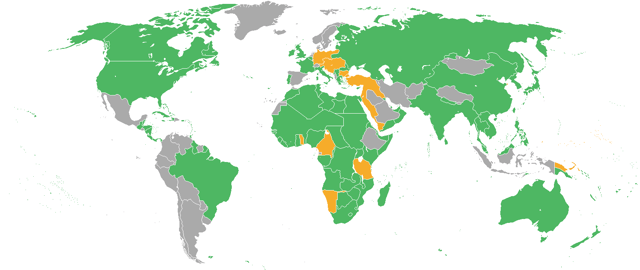
Map of the world showing the participants in World War I. Those fighting on the Entente's side (at one point or another) are depicted in green, the Central Powers in orange, and neutral countries in grey.
Following the assassination of the Austro-Hungarian Archduke of Franz Ferdinand by a Bosnian Serb, the Kaiser offered Emperor Franz Joseph full support for Austro-Hungarian plans to invade the Kingdom of Serbia, which Austria-Hungary blamed for the assassination. This unconditional support for Austria-Hungary was called a "blank cheque" by historians, including German Fritz Fischer. Subsequent interpretation – for example at the Versailles Peace Conference – was that this "blank cheque" licensed Austro-Hungarian aggression regardless of the diplomatic consequences, and thus Germany bore responsibility for starting the war, or at least provoking a wider conflict.
Germany began the war by targeting its chief rival, France.
Germany saw France as its principal danger on the European continent as it could mobilize much faster than Russia and bordered Germany's industrial core in the Rhineland. Unlike Britain and Russia, the French entered the war mainly for revenge against Germany, in particular for France's loss of Alsace-Lorraine to Germany in 1871. The German high command knew that France would muster its forces to go into Alsace-Lorraine. Aside from the very unofficial Septemberprogramm, the Germans never stated a clear list of goals that they wanted out of the war.[72]
Western Front
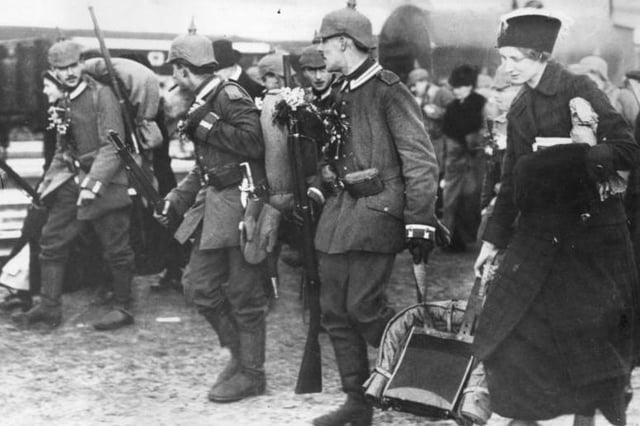
German troops beings mobilized, 1914
Germany did not want to risk lengthy battles along the Franco-German border and instead adopted the Schlieffen Plan, a military strategy designed to cripple France by invading Belgium and Luxembourg, sweeping down to encircle and crush both Paris and the French forces along the Franco-German border in a quick victory. After defeating France, Germany would turn to attack Russia. The plan required violating the official neutrality of Belgium and Luxembourg, which Britain had guaranteed by treaty. However, the Germans had calculated that Britain would enter the war regardless of whether they had formal justification to do so. At first the attack was successful: the German Army swept down from Belgium and Luxembourg and advanced on Paris, at the nearby River Marne. However, the evolution of weapons over the last century heavily favored defense over offense, especially thanks to the machine gun, so that it took proportionally more offensive force to overcome a defensive position. This resulted in the German lines on the offense contracting to keep up the offensive time table while correspondingly the French lines were extending. In addition, some German units that were originally slotted for the German far right were transferred to the Eastern Front in reaction to Russia mobilizing far faster than anticipated. The combined affect had the German right flank sweeping down in front of Paris instead of behind it exposing the German Right flank to the extending French lines and attack from strategic French reserves stationed in Paris. Attacking the exposed German right flank, the French Army and the British Army put up a strong resistance to the defense of Paris at the First Battle of the Marne, resulting in the German Army retreating.
The aftermath of the First Battle of the Marne was a long-held stalemate between the German Army and the Allies in dug-in trench warfare. Further German attempts to break through deeper into France failed at the two battles of Ypres (1st/2nd) with huge casualties. German Chief of Staff Erich von Falkenhayn decided to break away from the Schlieffen Plan and instead focus on a war of attrition against France. Falkenhayn targeted the ancient city of Verdun because it had been one of the last cities to hold out against the German Army in 1870, and Falkenhayn knew that as a matter of national pride the French would do anything to ensure that it was not taken. He expected that with proper tactics, French losses would be greater than those of the Germans and that continued French commitment of troops to Verdun would "bleed the French Army white" and then allow the German army to take France easily. In 1916, the Battle of Verdun began, with the French positions under constant shelling and poison gas attack and taking large casualties under the assault of overwhelmingly large German forces. However, Falkenhayn's prediction of a greater ratio of French killed proved to be wrong. Falkenhayn was replaced by Erich Ludendorff, and with no success in sight, the German Army pulled out of Verdun in December 1916 and the battle ended.
Eastern Front

Front line at the time of cease-fire and at the time of the Treaty of Brest-Litovsk
While the Western Front was a stalemate for the German Army, the Eastern Front eventually proved to be a great success. Despite initial setbacks due to the unexpectedly rapid mobilisation of the Russian army, which resulted in a Russian invasion of East Prussia and Austrian Galicia, the badly organised and supplied Russian Army faltered and the German and Austro-Hungarian armies thereafter steadily advanced eastward. The Germans benefited from political instability in Russia and its population's desire to end the war. In 1917 the German government allowed Russia's communist Bolshevik leader Vladimir Lenin to travel through Germany from Switzerland into Russia. Germany believed that if Lenin could create further political unrest, Russia would no longer be able to continue its war with Germany, allowing the German Army to focus on the Western Front.
In March 1917, the Tsar was ousted from the Russian throne, and in November a Bolshevik government came to power under the leadership of Lenin. Facing political opposition from the Bolsheviks, he decided to end Russia's campaign against Germany, Austria-Hungary, the Ottoman Empire and Bulgaria in order to redirect Bolshevik energy to eliminating internal dissent. In March 1918, by the Treaty of Brest-Litovsk, the Bolshevik government gave Germany and the Ottoman Empire enormous territorial and economic concessions in exchange for an end to war on the Eastern Front. All of the modern-day Baltic states (Estonia, Latvia and Lithuania) were given over to the German occupation authority Ober Ost, along with Belarus and Ukraine. Thus Germany had at last achieved its long-wanted dominance of "Mitteleuropa" (Central Europe) and could now focus fully on defeating the Allies on the Western Front. In practice, however, the forces that were needed to garrison and secure the new territories were a drain on the German war effort.
Colonies
Germany quickly lost almost all its colonies.
However, in German East Africa, an impressive guerrilla campaign was waged by the colonial army leader there, General Paul Emil von Lettow-Vorbeck. Using Germans and native Askaris, Lettow-Vorbeck launched multiple guerrilla raids against British forces in Kenya and Rhodesia. He also invaded Portuguese Mozambique to gain his forces supplies and to pick up more Askari recruits. His force was still active at war's end.[73]
1918
The defeat of Russia in 1917 enabled Germany to transfer hundreds of thousands of troops from the Eastern to the Western Front, giving it a numerical advantage over the Allies. By retraining the soldiers in new stormtrooper tactics, the Germans expected to unfreeze the battlefield and win a decisive victory before the army of the United States, which had now entered the war on the side of the Allies, arrived in strength.[74] However, the repeated German offensives in the spring of 1918 all failed, as the Allies fell back and regrouped and the Germans lacked the reserves needed to consolidate their gains. Meanwhile, soldiers had become radicalised by the Russian Revolution and were less willing to continue fighting. The war effort sparked civil unrest in Germany, while the troops, who had been constantly in the field without relief, grew exhausted and lost all hope of victory. In the summer of 1918, with the Americans arriving at the rate of 10,000 a day and the German reserves spent, it was only a matter of time before multiple Allied offensives destroyed the German army.[75]
Home front
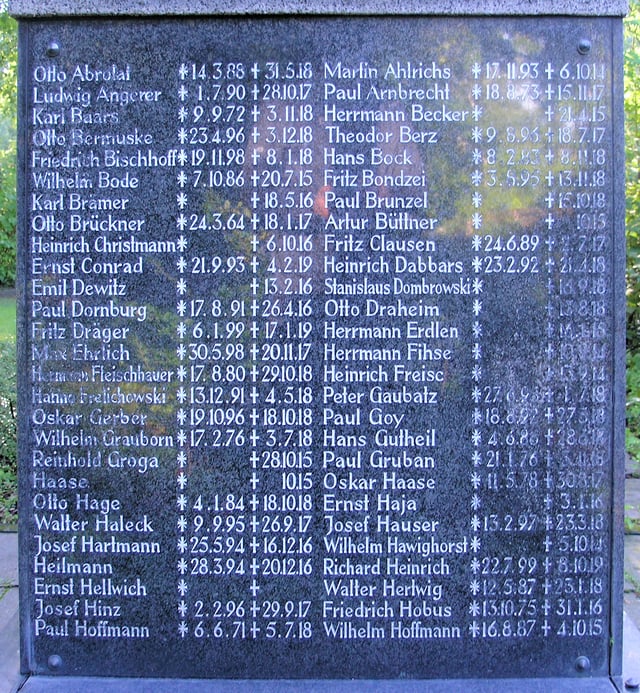
A war memorial in Berlin
The concept of "total war" meant that supplies had to be redirected towards the armed forces and, with German commerce being stopped by the Allied naval blockade, German civilians were forced to live in increasingly meagre conditions. First food prices were controlled, then rationing was introduced. During the war about 750,000 German civilians died from malnutrition.[76]
Towards the end of the war conditions deteriorated rapidly on the home front, with severe food shortages reported in all urban areas.
The causes included the transfer of many farmers and food workers into the military, combined with the overburdened railway system, shortages of coal, and the British blockade.
The winter of 1916–1917 was known as the "turnip winter", because the people had to survive on a vegetable more commonly reserved for livestock, as a substitute for potatoes and meat, which were increasingly scarce.
Thousands of soup kitchens were opened to feed the hungry, who grumbled that the farmers were keeping the food for themselves.
Even the army had to cut the soldiers' rations.[77] The morale of both civilians and soldiers continued to sink.
Revolt and demise
Many Germans wanted an end to the war and increasing numbers began to associate with the political left, such as the Social Democratic Party and the more radical Independent Social Democratic Party, which demanded an end to the war. The entry of the U.S. into the war in April 1917 changed the long-run balance of power in favour of the Allies.
The end of October 1918, in Kiel, in northern Germany, saw the beginning of the German Revolution of 1918–19. Units of the German Navy refused to set sail for a last, large-scale operation in a war which they saw as good as lost, initiating the uprising. On 3 November, the revolt spread to other cities and states of the country, in many of which workers' and soldiers' councils were established. Meanwhile, Hindenburg and the senior generals lost confidence in the Kaiser and his government.
Bulgaria signed the Armistice of Solun on 29 September 1918. The Ottoman Empire signed the Armistice of Mudros on 30 October 1918. Between 24 October and 3 November 1918, Italy defeated Austria-Hungary in the battle of Vittorio Veneto, which forced Austria-Hungary to sign the Armistice of Villa Giusti on 3 November 1918. So, in November 1918, with internal revolution, the Allies advancing toward Germany on the Western Front, Austria-Hungary falling apart from multiple ethnic tensions, its other allies out of the war and pressure from the German high command, the Kaiser and all German ruling kings, dukes, and princes abdicated, and German nobility was abolished. On 9 November, the Social Democrat Philipp Scheidemann proclaimed a republic. The new government led by the German Social Democrats called for and received an armistice on 11 November. It was succeeded by the Weimar Republic.[78] Those opposed, including disaffected veterans, joined a diverse set of paramilitary and underground political groups such as the Freikorps, the Organisation Consul, and the Communists.
Constitution
The Empire's legislation was based on two organs, the Bundesrat and the Reichstag (parliament).
There was universal male suffrage for the Reichstag, however legislation would have to pass both houses.
The Bundesrat contained representatives of the states.
Constituent states
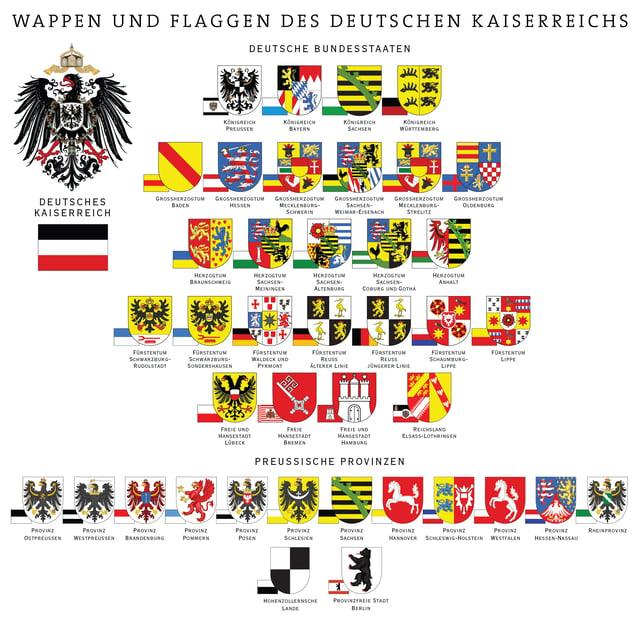
Coat of arms and flags of the constituent states in 1900
Before unification, German territory (excluding Austria and Switzerland) was made up of 27 constituent states. These states consisted of kingdoms, grand duchies, duchies, principalities, free Hanseatic cities and one imperial territory. The free cities had a republican form of government on the state level, even though the Empire at large was constituted as a monarchy, and so were most of the states. The Kingdom of Prussia was the largest of the constituent states, covering two-thirds of the empire's territory.
Several of these states had gained sovereignty following the dissolution of the Holy Roman Empire, and had been de facto sovereign from the mid-1600s onward. Others were created as sovereign states after the Congress of Vienna in 1815. Territories were not necessarily contiguous—many existed in several parts, as a result of historical acquisitions, or, in several cases, divisions of the ruling families. Some of the initially existing states, in particular Hanover, were abolished and annexed by Prussia as a result of the war of 1866.
Each component of the German Empire sent representatives to the Federal Council (Bundesrat) and, via single-member districts, the Imperial Diet (Reichstag). Relations between the Imperial centre and the Empire's components were somewhat fluid and were developed on an ongoing basis. The extent to which the German Emperor could, for example, intervene on occasions of disputed or unclear succession was much debated on occasion—for example in the inheritance crisis of the Lippe-Detmold.
Unusually for a federation and/or a nation-state, the German states maintained limited autonomy over foreign affairs and continued to exchange ambassadors and other diplomats (both with each other and directly with foreign nations) for the Empire's entire existence.
Shortly after the Empire was proclaimed, Bismarck implemented a convention in which his sovereign would only send and receive envoys to and from other German states as the King of Prussia, while envoys from Berlin sent to foreign nations always received credentials from the monarch in his capacity as German Emperor.
In this way, the Prussian foreign ministry was largely tasked with managing relations with the other German states while the Imperial foreign ministry managed Germany's external relations.
Map and table
 |
Other maps
Language
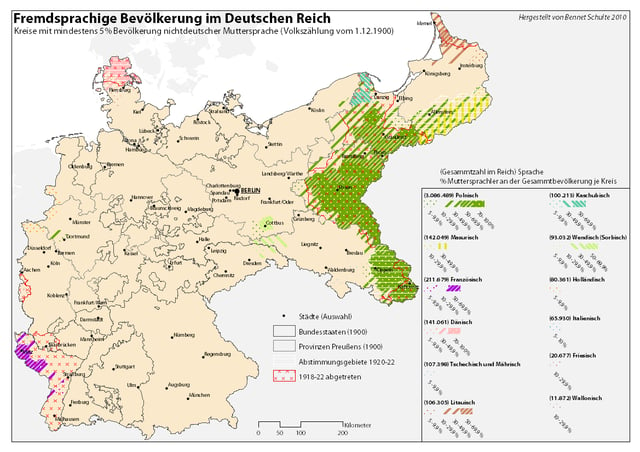
Percentage of linguistic minorities of the German Empire in 1900 by Kreis
About 92% of the population spoke German as their first language.
The only minority language with a significant number of speakers (5.4%) was Polish (a figure that rises to over 6% when including the related Kashubian and Masurian languages).
The non-German Germanic languages (0.5%), like Danish, Dutch and Frisian, were located in the north and northwest of the empire, near the borders with Denmark, the Netherlands, Belgium, and Luxembourg. Low German was spoken throughout northern Germany and, though linguistically as distinct from High German (Hochdeutsch) as from Dutch and English, is considered "German", hence also its name. Danish and Frisian were spoken predominantly in the north of the Prussian province of Schleswig-Holstein and Dutch in the western border areas of Prussia (Hanover, Westphalia, and the Rhine Province).
Polish and other Slavic languages (6.28%) were spoken chiefly in the east.[79]
A few (0.5%) spoke French, the vast majority of these in the Reichsland Elsass-Lothringen where francophones formed 11.6% of the total population.
1900 census results
| Language | Count | Percentage |
|---|---|---|
| German | 51,883,131 | 92.05 |
| German and a foreign language | 252,918 | 0.45 |
| Polish | 3,086,489 | 5.48 |
| French | 211,679 | 0.38 |
| Masurian | 142,049 | 0.25 |
| Danish | 141,061 | 0.25 |
| Lithuanian | 106,305 | 0.19 |
| Kashubian | 100,213 | 0.18 |
| Wendish (Sorbian) | 93,032 | 0.16 |
| Dutch | 80,361 | 0.14 |
| Italian | 65,930 | 0.12 |
| Moravian (Czech) | 64,382 | 0.11 |
| Czech | 43,016 | 0.08 |
| Frisian | 20,677 | 0.04 |
| English | 20,217 | 0.04 |
| Russian | 9,617 | 0.02 |
| Swedish | 8,998 | 0.02 |
| Hungarian | 8,158 | 0.01 |
| Spanish | 2,059 | 0.00 |
| Portuguese | 479 | 0.00 |
| Other foreign languages | 14,535 | 0.03 |
| Imperial citizens | 56,367,187 | 100 |
Linguistic maps
Religion
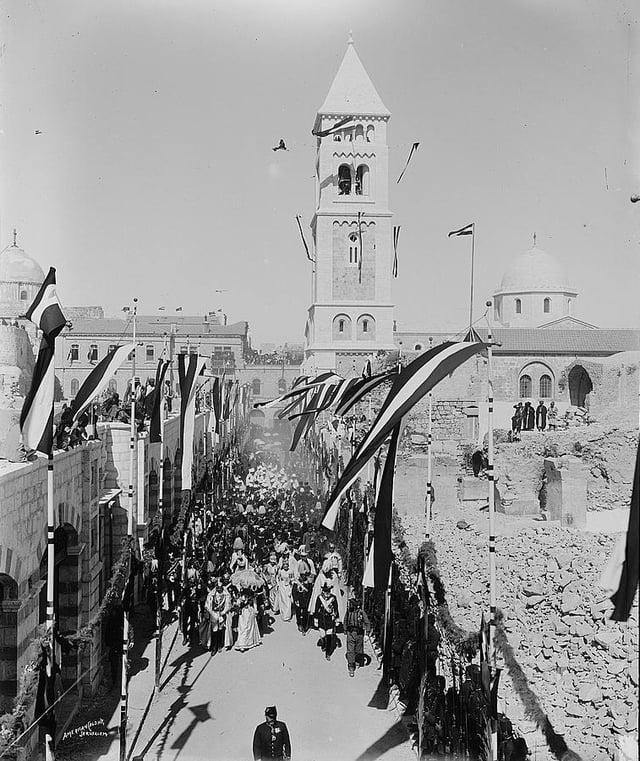
Emperor Wilhelm II, who was the Supreme Governor of the Evangelical Church of Prussia's older Provinces, and Empress Augusta Victoria after the inauguration of the Evangelical Church of the Redeemer in Jerusalem (Reformation Day, 31 October 1898)
Generally, religious demographics of the early modern period hardly changed. Still, there were almost entirely Catholic areas (Lower and Upper Bavaria, northern Westphalia, Upper Silesia, etc.) and almost entirely Protestant areas (Schleswig-Holstein, Pomerania, Saxony, etc.). Confessional prejudices, especially towards mixed marriages, were still common. Bit by bit, through internal migration, religious blending was more and more common. In eastern territories, confession was almost uniquely perceived to be connected to one's ethnicity and the equation "Protestant = German, Catholic = Polish" was held to be valid. In areas affected by immigration in the Ruhr area and Westphalia, as well as in some large cities, religious landscape changed substantially. This was especially true in largely Catholic areas of Westphalia, which changed through Protestant immigration from the eastern provinces.
Politically, the confessional division of Germany had considerable consequences.
In Catholic areas, the Centre Party had a big electorate.
On the other hand, Social Democrats and Free Trade Unions usually received hardly any votes in the Catholic areas of the Ruhr. This began to change with the secularization arising in the last decades of the German Empire.
| Area | Protestant | Catholic | Other Christian | Jewish | Other | |||||
|---|---|---|---|---|---|---|---|---|---|---|
| Number | % | Number | % | Number | % | Number | % | Number | % | |
| Prussia | 17,633,279 | 64,64 | 9,206,283 | 33,75 | 52,225 | 0,19 | 363,790 | 1,33 | 23,534 | 0,09 |
| Bavaria | 1,477,952 | 27,97 | 3,748,253 | 70,93 | 5,017 | 0,09 | 53,526 | 1,01 | 30 | 0,00 |
| Saxony | 2,886,806 | 97,11 | 74,333 | 2,50 | 4,809 | 0,16 | 6,518 | 0,22 | 339 | 0,01 |
| Württemberg | 1,364,580 | 69,23 | 590,290 | 29,95 | 2,817 | 0,14 | 13,331 | 0,68 | 100 | 0,01 |
| Baden | 547,461 | 34,86 | 993,109 | 63,25 | 2,280 | 0,15 | 27,278 | 1,74 | 126 | 0,01 |
| Alsace-Lotharingia | 305,315 | 19,49 | 1,218,513 | 77,78 | 3,053 | 0,19 | 39,278 | 2,51 | 511 | 0,03 |
| German Empire | 28,331,152 | 62,63 | 16,232,651 | 35,89 | 78,031 | 0,17 | 561,612 | 1,24 | 30,615 | 0,07 |
Legacy

War flag of the German Empire. In 1956, the Iron Cross was re-introduced as the symbol of the Bundeswehr
The defeat and aftermath of the First World War and the penalties imposed by the Treaty of Versailles shaped the positive memory of the Empire, especially among Germans who distrusted and despised the Weimar Republic. Conservatives, liberals, socialists, nationalists, Catholics and Protestants all had their own interpretations, which led to a fractious political and social climate in Germany in the aftermath of the empire's collapse.
Under Bismarck, a united German state had finally been achieved, but it remained a Prussian-dominated state and did not include German Austria as Pan-German nationalists had desired. The influence of Prussian militarism, the Empire's colonial efforts and its vigorous, competitive industrial prowess all gained it the dislike and envy of other nations. The German Empire enacted a number of progressive reforms, such as Europe's first social welfare system and freedom of press. There was also a modern system for electing the federal parliament, the Reichstag, in which every adult man had one vote. This enabled the Socialists and the Catholic Centre Party to play considerable roles in the empire's political life despite the continued hostility of Prussian aristocrats.
The era of the German Empire is well remembered in Germany as one of great cultural and intellectual vigour.
Thomas Mann published his novel Buddenbrooks in 1901. Theodor Mommsen received the Nobel prize for literature a year later for his Roman history. Painters like the groups Der Blaue Reiter and Die Brücke made a significant contribution to modern art. The AEG turbine factory in Berlin by Peter Behrens from 1909 can be regarded as a milestone in classic modern architecture and an outstanding example of emerging functionalism. The social, economic, and scientific successes of this Gründerzeit, or founding epoch, have sometimes led the Wilhelmine era to be regarded as a golden age.
In the field of economics, the "Kaiserzeit" laid the foundation of Germany's status as one of the world's leading economic powers. The iron and coal industries of the Ruhr, the Saar and Upper Silesia especially contributed to that process. The first motorcar was built by Karl Benz in 1886. The enormous growth of industrial production and industrial potential also led to a rapid urbanisation of Germany, which turned the Germans into a nation of city dwellers. More than 5 million people left Germany for the United States during the 19th century.[81]
Sonderweg
Many historians have emphasized the central importance of a German Sonderweg or "special path" (or "exceptionalism") as the root of Nazism and the German catastrophe in the 20th century. According to the historiography by Kocka (1988), the process of nation-building from above had very grievous long-term implications. In terms of parliamentary democracy, Parliament was kept weak, the parties were fragmented, and there was a high level of mutual distrust. The Nazis built on the illiberal, anti-pluralist elements of Weimar's political culture. The Junker elites (the large landowners in the east) and senior civil servants used their great power and influence well into the twentieth century to frustrate any movement toward democracy. They played an especially negative role in the crisis of 1930–1933. Bismarck's emphasis on military force amplified the voice of the officer corps, which combined advanced modernisation of military technology with reactionary politics. The rising upper-middle class elites, in the business, financial and professional worlds, tended to accept the values of the old traditional elites. The German Empire was for Hans-Ulrich Wehler a strange mixture of highly successful capitalist industrialisation and socio-economic modernisation on the one hand, and of surviving pre-industrial institutions, power relations and traditional cultures on the other. Wehler argues that it produced a high degree of internal tension, which led on the one hand to the suppression of socialists, Catholics and reformers, and on the other hand to a highly aggressive foreign policy. For these reasons Fritz Fischer and his students emphasised Germany's primary guilt for causing the First World War.[82]
Hans-Ulrich Wehler, a leader of the Bielefeld School of social history, places the origins of Germany's path to disaster in the 1860s–1870s, when economic modernisation took place, but political modernisation did not happen and the old Prussian rural elite remained in firm control of the army, diplomacy and the civil service. Traditional, aristocratic, premodern society battled an emerging capitalist, bourgeois, modernising society. Recognising the importance of modernising forces in industry and the economy and in the cultural realm, Wehler argues that reactionary traditionalism dominated the political hierarchy of power in Germany, as well as social mentalities and in class relations (Klassenhabitus). The catastrophic German politics between 1914 and 1945 are interpreted in terms of a delayed modernisation of its political structures. At the core of Wehler's interpretation is his treatment of "the middle class" and "revolution", each of which was instrumental in shaping the 20th century. Wehler's examination of Nazi rule is shaped by his concept of "charismatic domination", which focuses heavily on Adolf Hitler.[83]
The historiographical concept of a German Sonderweg has had a turbulent history. 19th century scholars who emphasised a separate German path to modernity saw it as a positive factor that differentiated Germany from the "western path" typified by Great Britain. They stressed the strong bureaucratic state, reforms initiated by Bismarck and other strong leaders, the Prussian service ethos, the high culture of philosophy and music, and Germany's pioneering of a social welfare state. In the 1950s, historians in West Germany argued that the Sonderweg led Germany to the disaster of 1933–1945. The special circumstances of German historical structures and experiences, were interpreted as preconditions that, while not directly causing National Socialism, did hamper the development of a liberal democracy and facilitate the rise of fascism. The Sonderweg paradigm has provided the impetus for at least three strands of research in German historiography: the "long 19th century", the history of the bourgeoisie, and comparisons with the West. After 1990, increased attention to cultural dimensions and to comparative and relational history moved German historiography to different topics, with much less attention paid to the Sonderweg. While some historians have abandoned the Sonderweg thesis, they have not provided a generally accepted alternative interpretation.[84]
Territorial legacy

German territories lost in both World Wars are shown in black, present-day Germany is marked dark grey on this 1914 map
In addition to present-day Germany, large parts of what comprised the German Empire now belong to several other modern European countries.
When lost from Germany | German name | Country | Region |
|---|---|---|---|
World War I | Elsaß-Lothringen | France | DépartementsofBas-RhinandHaut-Rhin(both withinAlsaceregion), anddépartementofMoselle(northeastern part of theLorraineregion) |
World War I | Eupen-Malmedy | Belgium | Two towns ofEupenandMalmedyand themunicipalitiesofAmel,Büllingen,Burg-Reuland,Bütgenbach,Kelmis,Lontzen,Raeren,WaimesandSt. Vith(all are parts of theprovince of LiègeinWalloniaregion on the Belgian–German border) |
World War II | Wylerberg | Netherlands | Duivelsberg(German:Wylerberg), an uninhabited hill and some nearby slivers of land annexed by the Netherlands after WWII |
World War I | Nordschleswig | Denmark | South Jutland County(excluding towns of Taps, Hejle and Vejstrup), and the towns of Hviding, Roager and Spandet |
World War I | Hultschiner Ländchen | Czech Republic | Hlučín Region, on the Czech–Polish border in Silesia, from which most Germans weredeported following WWII.Part of theCzechoslovak Socialist Republicuntil its dissolution in 1990. |
World War I | Memelland | Lithuania | Klaipėda Region, transferred toSoviet Lithuaniaand from which Germans weredeported following WWII; continued as a part of Lithuania following thecollapse of the Soviet Union |
Both World Wars | Schlesien,Ostbrandenburg,Ermland,Masuren,Westpreußen,Provinz Posen, southernOstpreußen, central and eastern parts ofPommern | Poland | Northern and western parts of the country, includingPomerania,Silesia,Lubusz Land,Warmia and Masuria, from all of which Germans weredeported following WWII |
Both World Wars | NorthernOstpreußen | Russia | Kaliningrad Oblastexclave on the Baltic, from which Germans weredeported following WWII.Transferred to the Russian SFSRand continued as a part of Russia following thecollapse of the Soviet Union |
See also
Economic history of Germany
German Army (German Empire)
German colonial empire
House of Hohenzollern
Imperial German Navy
Kingdom of Germany
List of German monarchs
List of German monarchs in 1918
Wilhelminism
